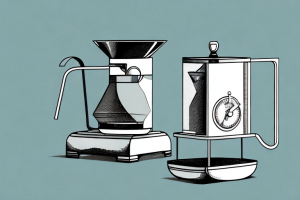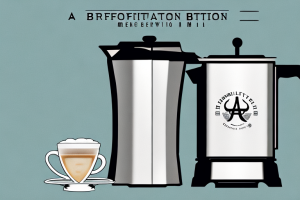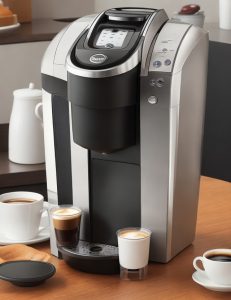Japanese Coffee Maker

A traditional japanese coffee maker with a steaming cup of coffee
If you’re a coffee lover, you know that brewing the perfect cup of coffee is an art. With a coffee maker, you can enjoy a delicious cup of coffee with ease in the comfort of your own home. But have you ever considered a Japanese coffee maker? In this article, we’ll dive into the world of Japanese coffee makers and discuss their history, popularity, and features.
The History of Japanese Coffee Makers: From Traditional to Modern Designs
Japan has a rich coffee culture that dates back to the early 1900s, where coffee was imported by European traders and quickly became popular among Japanese elites. The first Japanese coffee maker was invented in the 1920s by Sanyo Sangyo, a company known for creating innovative and unique products. The first coffee makers were made of copper, brass, and glass, and required manual brewing. It wasn’t until the 1950s that electric coffee makers were introduced in Japan.
Today, Japanese coffee makers are known for their sleek and modern designs, with many manufacturers incorporating high-quality materials such as stainless steel and borosilicate glass.
In addition to their stylish designs, Japanese coffee makers are also known for their advanced technology. Many models feature programmable settings, allowing users to customize their brewing preferences. Some even have built-in grinders, ensuring that the coffee beans are freshly ground before brewing.
Another unique feature of Japanese coffee makers is their emphasis on the pour-over method. This method involves pouring hot water over the coffee grounds in a slow, steady stream, resulting in a rich and flavorful cup of coffee. Many Japanese coffee makers are designed specifically for this method, with narrow spouts and precise temperature control.
Why Japanese Coffee Makers are Gaining Popularity in the West
In recent years, Japanese coffee makers have gained popularity in the West due to their unique designs, attention to detail, and emphasis on flavor. Japanese manufacturers are known for prioritizing the taste and quality of coffee above all else, resulting in coffee makers that produce a clean, crisp, and flavorful cup of coffee. Additionally, the minimalist design of Japanese coffee makers appeals to Western consumers who are looking for modern and sleek kitchen appliances.
Another reason for the popularity of Japanese coffee makers in the West is their focus on sustainability. Many Japanese coffee makers are designed to be eco-friendly, using materials that are recyclable and reducing energy consumption during the brewing process. This aligns with the growing trend of environmentally conscious consumers who are looking for products that are both high-quality and sustainable.
Comparing Japanese Coffee Makers to Other Types of Coffee Makers
When compared to other types of coffee makers, Japanese coffee makers have several advantages. For example, the pour-over method used in many Japanese coffee makers allows for more control over the brewing process, resulting in a customized cup of coffee. Additionally, Japanese coffee makers are known for their precise heat control, which ensures that coffee is brewed at the optimal temperature for maximum flavor extraction.
Another advantage of Japanese coffee makers is their durability. Many Japanese coffee makers are made with high-quality materials, such as stainless steel and ceramic, which can withstand frequent use and last for years. This makes them a great investment for coffee lovers who want a reliable and long-lasting coffee maker.
Furthermore, Japanese coffee makers often have a sleek and minimalist design, which can add a touch of elegance to any kitchen or coffee shop. Their simple yet stylish appearance can also make them a great gift for coffee enthusiasts who appreciate both form and function.
How to Choose the Best Japanese Coffee Maker for Your Needs
When choosing a Japanese coffee maker, it’s important to consider several factors. First, consider the size of the coffee maker and how much coffee you want to brew at once. Next, consider the type of coffee maker, as there are several different types available, including pour-over, siphon, and drip coffee makers. Additionally, consider the materials used to make the coffee maker, as some materials may affect the flavor of your coffee.
Another important factor to consider when choosing a Japanese coffee maker is the brewing time. Some coffee makers take longer to brew than others, so if you’re in a hurry in the morning, you may want to choose a coffee maker that brews quickly. On the other hand, if you have more time to spare and enjoy the brewing process, a slower brewing coffee maker may be a better choice.
Lastly, consider the price of the coffee maker. Japanese coffee makers can range in price from very affordable to quite expensive. While a higher price tag may indicate higher quality materials and construction, it’s important to choose a coffee maker that fits within your budget and meets your specific needs.
Understanding the Different Types of Japanese Coffee Makers and Their Features
The type of Japanese coffee maker you choose can have a significant impact on the flavor of your coffee. Pour-over coffee makers, for example, are known for producing a clean and balanced cup of coffee, while siphon coffee makers are known for their unique brewing process that produces a rich and flavorful cup of coffee. Additionally, some Japanese coffee makers come with unique features, such as heat control settings and automatic shut-off timers.
Another type of Japanese coffee maker is the drip coffee maker, which is similar to the pour-over coffee maker but has a built-in filter. This type of coffee maker is convenient and easy to use, making it a popular choice for home use. On the other hand, the French press coffee maker, although not originally from Japan, has gained popularity in the country due to its ability to produce a strong and bold cup of coffee.
When choosing a Japanese coffee maker, it’s important to consider not only the type of coffee maker but also the material it’s made of. Ceramic coffee makers, for example, are known for their ability to retain heat and produce a consistent cup of coffee, while glass coffee makers allow you to see the brewing process and are easy to clean. Stainless steel coffee makers are durable and long-lasting, making them a great investment for coffee lovers who want a coffee maker that will last for years to come.
Step-by-Step Guide on How to Brew Coffee with a Japanese Coffee Maker
Brewing coffee with a Japanese coffee maker may seem complicated, but it’s actually a straightforward process. To begin, start by grinding your coffee beans and placing them into the filter or brewing chamber of the coffee maker. Next, add hot water to the coffee maker and wait for the coffee to brew. Each type of coffee maker may have specific steps, but overall the process is simple and straightforward.
One important thing to keep in mind when brewing coffee with a Japanese coffee maker is the water temperature. The ideal temperature for brewing coffee is between 195-205°F (90-96°C). If the water is too hot, it can over-extract the coffee and result in a bitter taste. On the other hand, if the water is not hot enough, the coffee may be under-extracted and taste weak. Therefore, it’s important to use a thermometer to ensure the water temperature is within the recommended range.
Tips and Tricks for Making the Perfect Cup of Coffee with Your Japanese Coffee Maker
With a Japanese coffee maker, you can enjoy a delicious cup of coffee with ease. To make the perfect cup of coffee, consider using high-quality coffee beans and brewing at the optimal temperature for your chosen brewing method. Additionally, experimenting with different grind sizes and brew times can help you find the perfect balance of flavor and aroma.
Another important factor to consider when making coffee with a Japanese coffee maker is the water you use. Using filtered or purified water can greatly improve the taste of your coffee, as tap water can contain impurities that affect the flavor. It’s also important to clean your coffee maker regularly to prevent any buildup of oils or residue that can affect the taste of your coffee.
When it comes to serving your coffee, consider using a pre-warmed mug or carafe to keep your coffee hot for longer. You can also experiment with adding different types of milk or sweeteners to your coffee to create your perfect cup. And don’t forget to enjoy your coffee slowly, savoring each sip and taking in the aroma and flavor of your perfectly brewed cup.
Cleaning and Maintenance Tips for Your Japanese Coffee Maker
To ensure the longevity of your Japanese coffee maker, it’s important to properly clean and maintain it. This may involve flushing the coffee maker with hot water, descaling the internal components, and wiping down the exterior with a soft cloth. Be sure to follow the manufacturer’s instructions for cleaning and maintenance to ensure your coffee maker remains in top condition.
Additionally, it’s important to regularly replace the coffee filter in your Japanese coffee maker. Over time, the filter can become clogged with coffee grounds and oils, which can affect the taste of your coffee and even damage the machine. Check the manufacturer’s recommendations for how often to replace the filter, and be sure to use the correct type of filter for your specific coffee maker.
Japanese Coffee Culture: How It Influences the Design and Functionality of Coffee Makers
Japanese coffee culture is known for its attention to detail and emphasis on quality. This philosophy is reflected in the design and functionality of Japanese coffee makers, which are designed with the user in mind and prioritize the taste and quality of coffee above all else. Additionally, Japanese coffee makers are often designed to be both functional and aesthetically pleasing, with sleek and modern designs that complement any kitchen.
One unique aspect of Japanese coffee culture is the emphasis on pour-over coffee. This method involves pouring hot water over coffee grounds in a filter, allowing the water to slowly drip through and extract the flavor. Many Japanese coffee makers are specifically designed for pour-over coffee, with features such as a narrow spout for precise pouring and a cone-shaped filter for optimal extraction.
Another way that Japanese coffee culture influences coffee maker design is through the use of technology. Many Japanese coffee makers incorporate advanced features such as programmable brewing, temperature control, and even smartphone connectivity. These features allow coffee lovers to customize their brewing experience and achieve the perfect cup of coffee every time.
In Conclusion
A Japanese coffee maker is a unique and functional addition to any kitchen. With their attention to detail, emphasis on quality, and sleek designs, it’s no wonder that Japanese coffee makers have gained popularity in the West. Whether you’re a coffee enthusiast or simply looking for a high-quality coffee maker, a Japanese coffee maker is an excellent choice that is sure to provide a delicious and flavorful cup of coffee every time.
Additionally, Japanese coffee makers often incorporate advanced brewing technologies that allow for precise temperature control and extraction, resulting in a more consistent and flavorful cup of coffee. Some models even have built-in grinders, allowing you to grind fresh coffee beans right before brewing for the ultimate coffee experience. With their combination of style, functionality, and advanced brewing technology, a Japanese coffee maker is a must-have for any coffee lover.



